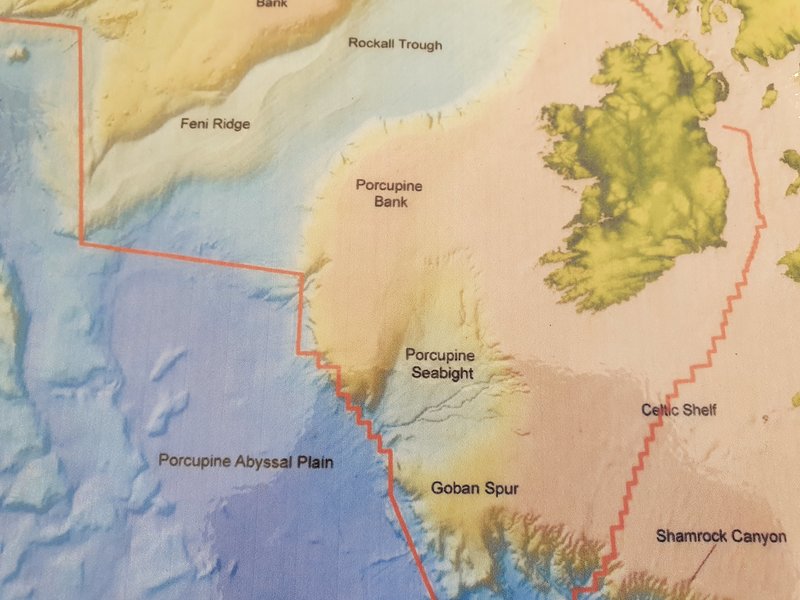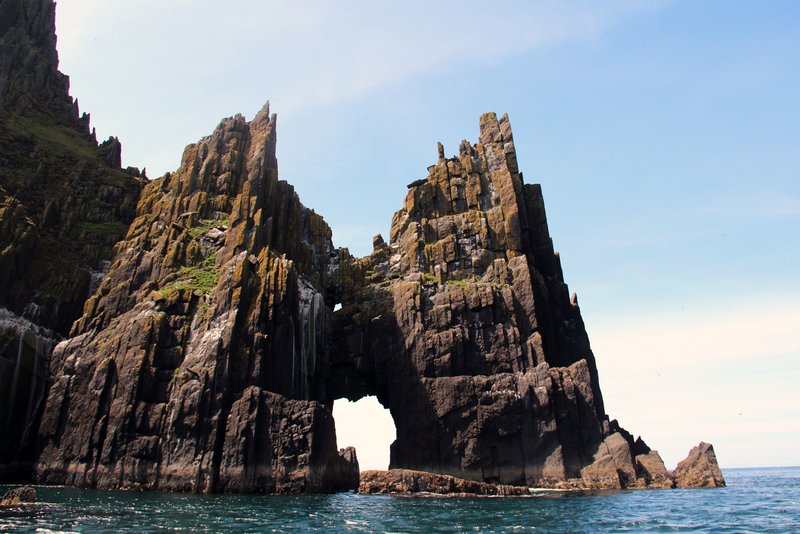Four Porcupines in the NE Atlantic & a Dolphins' Barn In Dublin!
The Real Map of Ireland

Cathedral Rocks on the Outer Blasket Islands

"Jewish Penicillin" - An Ameliorating Home Remedy for a Viral Respiratory Infection
Four Porcupines in the North East Atlantic (!) and a Dolphins' Barn in Dublin (!)
Did you ever wonder why there are 4 places in the North East Atlantic named after a porcupine and what exactly is a porcupine?? Is it some kind of mythical creature that lives under the sea (?) or are these areas named for some other reason?
Unfortunately the porcupine is not some kind of fabled sea creature as imagined, rather it is a large rodent-like animal and classified in the same order as rats, mice and beavers. It looks a little like our hedgehog, but not as cute and cuddly (ouch!) and not related, as that animal is in the same order as shrews and moles. The hair of the porcupine, called quills, has evolved into the same sort of defensive mechanism as the hedgehog and it used to be believed that it could fire its quills at enemies but nowadays it is accepted that this is not the case but the quills dislodge easily if touched by a predator and there are sharp barbs on the end to penetrate the flesh. It is generally avoided by predators as in extreme circumstances it will turn its rear to them and thrust at them with its strongest quills which can be up to 14 inches long on its rear end. But what has all this to do with The Porcupine Bank; The Porcupine Canyon; The Porcupine Seabight and The Porcupine Abyssal Plain in the NE Atlantic?
The answer to the riddle lies with the HMS "Porcupine" [1844-1883] a 490 ton Royal Navy 3-gun (3 X 32 pounders), wooden, paddle-wheel steamer, commissioned in 1844 for hydrographic survey work in the Atlantic, in particular looking for a suitable track and suitable gradient for a new underwater telegraph cable from Europe to America which eventually resulted in the Atlantic cable from Valentia island, Co. Kerry to Heart's Content in Newfoundland. In 1862, under the command of Richard Hoskyn, she discovered a shallow and extensive bank 120 miles west of Ireland ever since known as The Porcupine Bank. The bank is approx. 45 nautical miles NS X 30 miles EW [1,350 sq. mi.] and ranges in depth from 200 meters at its outer edge to only 148 m. depth at its NW section. HMS "Porcupine" followed in the tradition of naming a R.N. gunboat "Porcupine" [9 in total from 1746], even though we now know, as above, that porcupines do not fire their quills at their enemies as was then believed, and with her two funnels fore and aft of the machinery spaces and with her bowsprit and two-mast brigantine rig for auxiliary sailing, she also bristled like a porcupine.
In 1869-70, under the command of Captain Calver and with the naturalist Gwynn Jeffries as Scientific Officer (also Dr. Carpenter & Wyville Thomson) they disproved the so called Azoic (Lifeless) Hypothesis or Abyssus Theory that no life existed below 300 fathoms because of lack of sunlight penetration into the abyssal deep, incorrect information re temperature gradient and also misconceptions re the resilience and adaptations of living creatures to withstand the enormous pressure with increasing depth, by dredging up living animals from the deep off the west coast of Ireland / France in an area now know as The Porcupine Abyssal Plain ranging in depth from 3,000 to 5,000 meters and laid the foundation work for most of the practical and innovative dredging and sounding techniques later used on the greatest oceanographic expedition ever undertaken, by the HMS "Challenger" Expedition of 1872-76.
In some respects the early hydrographic surveys (1862) and later scientific expeditions (1869-70) of HMS "Porcupine" were the beginning of oceanography as we know it today and in recognition of this, a new marine natural history society was formed in Edinburgh Museum in Scotland by a group of enthusiastic conchologists in 1977 called The Porcupine Marine Natural History Society for the study, not just of molluscs, but "the ecology and generality of distribution of marine flora and fauna in the NE Atlantic" continuing to carry on the traditions of the early naturalists and a very welcoming and inclusive forum for marine naturalists both young and old today.
Porcupine Seabight and Porcupine Canyon
Seabight is a very interesting term and the term "bight" means primarily a loop made in a rope. "Keep out of the bight!!!" is a term you may hear on a fishing boat as the fishing gear is shot out the stern and an inexperienced crew member has his foot inside a slack bight of rope on the deck that is about to pull taut as the fishing gear goes out over the stern and he is in danger of going out with it! When used with the term sea as in "seabight" it refers to a curve in a coast, larger than, or with not as much curve as a bay. In the case of The Porcupine Seabight it refers to a broad, deep [circa 3,000 meters depth at its mouth] underwater bay approx. 23,000 square miles in extent cut into the continental shelf edge [circa 500 meters depth at the inner shelf top] about 100 miles south west of the Blasket Islands, Co. Kerry, Ireland S.W.
It is an area of rich marine productivity and a fantastically rich maritime habitat as the strong underwater tides and currents coming in from the deep abyssal plain swirl around the sides of the shelf edge and there is a great upwelling and mixing of nutrients and it is an area of great planktonic abundance including dense swarms of plankton and krill rising to the surface along the slope edges, rising in the mornings towards the sunlight and descending back towards the ocean floor in the evenings, on which the blue whales feed. This diurnal, vertical migration of plankton to and from the surface of the oceans worldwide is the single greatest migration of animals on the planet and the production of oxygen as a by-product of the photosynthesis of phytoplankton - converting carbon dioxide and sunlight into sugars for energy - is also responsible for an astonishing 70% of the oxygen in the atmosphere and makes life possible for us humans on earth. Rain forests provide about 28% of the oxygen in the atmosphere and it is estimated that one miniscule phytoplankton - Prochlorococcus - provides the oxygen for one in every 5 breaths that we breathe. It is time that we paid more attention to the beneficial microbial health of our planet.
The topsides of the slopes have large underwater gardens of soft, delicate, cold-water coral waving and filter feeding as are the anemones and other deep-water molluscs. Tuna, including Blue fin tuna come to feed here also when the sea water temperature is about 15 degrees Celsius and the summer breeding birds on the Outer Blasket Islands like the Guillemots, Puffins, Fulmar petrels. Manx shearwaters and Storm petrels come out as far as here to catch some of the abundant fish to bring back to their hungry waiting broods on the Blaskets.
They know where the shelf edge lies beneath the open ocean from the different colouration in the water, and also from the eddying and rippling of the water and changing direction of the ocean currents. Procellariiformes [Tubenoses like shearwaters and petrels] in particular are keenly aware of the olfactory landscape of the oceans and use their highly developed olfactory senses to literally navigate by their noses to areas like the shelf edge where [invisible to us with our limited senses] clouds of Di-methyl Sulphide [DMS] indicate the presence of decaying algae or phytoplankton being grazed on by zooplankton and krill, who are in turn predated on by whitebait and other small fish and even by blue whales. These DMS hotspots in the open ocean are clearly discernible to the Procellariiformes, just like neon signs indicate restaurants to humans in urban landscapes.
The recently investigated Porcupine Canyon lies further west about 180 nautical miles west of the Blaskets and is an exceptionally deep underwater canyon from a depth of approx.700 meters to approx. 3,000 meters underwater with steep precipitous sides and also a rich and exceptional maritime habitat especially for sperm whales, deep diving for up to an hour at a time after squid, and also various varieties of beaked whales including Cuvier's, Gervais', Sowerby's and Trues' beaked whales and also Northern Bottlenose whales, all of whom are often washed up on the shores here in Kerry as victims of offshore sonar arrays from oil exploration vessels booming out deafening noise underwater in incredible decibels and also underwater naval sonar exercises by various western powers engaged in Cold War war-games, all of which destroy the whales' integral sonar and echo location systems which are essential both for navigation, communication and finding prey.
The sperm whale makes the loudest noise in the animal kingdom at up to 230 decibels (dB) which is louder than the sound of a jet engine taking off (188 dB) and can be heard underwater over thousands of miles in the open ocean, necessary when there are so few of a species over such a vast area and especially when they want to find a mate (!), but the real damage is done by the seismic air gun arrays of oil and gas exploration vessels sending off bursts of up to 240 dB every few minutes and often up to 7,000 bursts of these volleys every 24 hr. period. This noise pollution in the underworld of our oceans is lethal to cetaceans, especially deep diving ones, and the bodies of beaked and bottlenose whales are the silent sirens washed up on our shores informing those with ears to hear of the destruction and abuse of our oceans.
HMS "Porcupine" and "the St. Kilda boat cough" -"cnatan-na-Gall" ("The Strangers cough")
It would be difficult to leave any discussion of the Porcupine without mentioning the association of the HMS "Porcupine" with the well documented annual affliction suffered by the inhabitants of the remote St. Kilda islands, an archipelago situated 40 miles west of the main Outer Hebrides, during the 17th to 19th centuries, known as the St. Kilda boat cough or known to themselves in Scot's Gaaelic as "cnatan-na-Gall" meaning "the Strangers' cough" where "Strangers" as in Irish Gaelic "Stráinséirí" means visitors or tourists. This medical phenomenon was first noted in 1697 and more or less persisted until the island was finally evacuated in 1930. Shortly after the HMS "Porcupine", this time commanded by Captain Otter, brought visitors ["na Gall" or "Strangers"] there in June 1860. a visiting physician also arrived there from a sailing cruise among the Western Isles and recorded that all the inhabitants had developed flu like symptoms 2 to 3 days after the arrival of the "Porcupine". In retrospect and from scientific papers - ["The St. Kilda boat cough under the microscope- Published online August 2008, P. Stride, Physician"] - it appears that the same virus that causes the common cold - Rhinovirus - may have been the cause of the infection [ although he does not fully exclude Coronavirus (types1-3)] and that the isolated community had not built up any herd immunity, which makes one think of native communities all over the world from the native peoples of North and South America to the Pacific Islanders, all of whose populations were decimated by non-immunity from numerous more lethal European borne diseases and viruses. A proportion of the St. Kilda islanders further developed pneumonia and died.
The present pandemic of Coronavirus - Covid-19 - gives us some idea of how these isolated immune-deficient populations must have suffered on an almost annual basis, especially with the arrival of steam driven vessels rather than the less frequently landing sailing vessels, making their contacts with the outside world more frequent, although there appears to be some evidence that they built up some immunity over time.
Along the west coasts of Ireland and Scotland this medical phenomenon of getting "the bug" with the annual influx of outside visitors from the mainland in early summer is well known, although usually not with such serious consequences, and is the reason why island communities along the west coast in particular are trying to keep visitors away in this present crisis.
It is interesting to note that the St. Kildans used "gibben" or "fowl" fat to cure the condition and presumably by "gibben" or fowl fat they were referring to a broth or soup made of the plump young fledglings of the seabirds that constituted their summer diets, as this was a recurring seasonal affliction brought on by the presence of summer visitors. This would not be dissimilar to the boiled chicken broth known affectionately as "Jewish Penicillin" consisting of a whole chicken, including carcass, skin and bones, left simmering for up to 2 hrs. and proven to be beneficial for upper respiratory inflammation and a cure for the common cold caused by the Rhinovirus.
The secret ingredients in the various recipes for chicken broth may lie in including the carcass, skin and bones; large selection of root vegetables including some carrots, celery, onions, parsnip, sweet potato, (turnip) and whole fresh dill, sea salt, black pepper; long simmering period (up to 2 hrs.) and also the beneficial effects of leaving it aside for a day in the fridge (like potato salad) to avail of the beneficial microbes created by the slight fermentation process. A 3-year study in 1993 by Dr. Stephen Rennard from the University of Nebraska Medical Centre showed that it slowed down the movement of white blood cells which inhibits mucus production and inflammation and a 2000 study in Journal of the American College of Chest Physicians showed that it helped relieve upper respiratory inflammation. Please check out the video on how to make a version of Jewish chicken broth on the left side panel above.
Trying to explain the reason why there are four Porcupines in the North East Atlantic has taken a long and circuitous route, like the wandering transect survey lines of the HMS "Porcupine" herself, taking us from a description of the much misunderstood porcupine to a St. Kildan version of a cure for the common cold, but I hope that you have found it an interesting voyage of discovery and we still have not come to the reason(s) why there is a Dolphins' barn in Dublin city (?)................. but that is a story for another day........
Captain Whales Galore 28.03.2020
Log of the Whale Watching Tour Boat M.V. "Blasket Princess" [in lockdown]

























